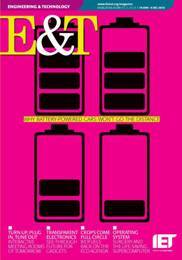Institution of Engineering and Technology Says Electric Cars Unlikely Ever To Offer A Viable Alternative To Conventional Powered Models
 Engineering and Technology Magazine |
SEE ALSO: Electric Vehicles-Solution or Diversion?
HERTFORDSHIRE, UK - June 30, 2010: Long-term limitations in battery technology could restrict electric cars to under a 100-mile range – while rapid charging is likely to limit battery life to just two years
An investigation by E&T magazine has raised serious questions about the viability of investing in the production of EV batteries using lithium-ion or any other current technology – plus the millions required to build the supporting infrastructure – suggesting the Government would be better placed to encourage the development of high efficiency diesel models and hybrids.
With consumers indicating that they will resist switching to electric cars until their overall performance more closely matches conventional models, limits in battery technology are forcing manufacturers to restrict plans to cars with effectively the same range as electric vehicles made in 1910 – and no obvious solutions are on the horizon.
The article in the latest issue of E&T (issue 9, out 17 June, published by the Institution of Engineering and Technology) gives the example of a standard model Ford Focus or Volkswagen Golf being capable of travelling for over 600km – in mixed driving conditions – on one tank of fuel and easily maintaining 70mph. However, for an electric car to offer a similar level of performance, E&T experts calculated that the batteries alone would weigh 1.5 tons, would be larger than a complete conventional car and would cost approximately £100,000.
While progress on costs is expected in the next ten years, a battery-powered car will remain significantly more expensive and heavier than a conventional car and their realistic range is likely to remain at around 100 miles – with possibly half that range in winter.
And with the majority of UK electricity likely to be from non-renewable sources for the next ten years an electric vehicle could actually contribute more CO2to the environment than a current high efficiency diesel model.
Put simply, battery technology has at least three fundamental problems that will remain difficult to overcome.
Firstly, while the performance of electronics has increased by some 10,000% in the past 35 years, the performance of battery technology has only increased six-fold in the past century. A similar increase would be required for batteries to give EVs the level of performance demanded by current car owners, but in around ten years.
Secondly, manufacturers already know that to have any hope of getting a reasonable life from lithium-ion batteries they should not be run from full to empty but should be kept at between 20%-80% of their charge – yet car manufacturers’ range calculations are based on running a complete cycle from full battery to empty.
Thirdly, charging remains a major stumbling block. Recharging an EV battery on a domestic supply is likely to take around 13 hours. As laptop and mobile-phone owners have come to understand, the useful lifetime of a lithium-ion battery is only a few years – rapid charging and discharging cycles damage the battery and cut its useful capacity. Further complications arise with much lower EV charging times quoted for up-rated power supplies, as no one knows what the impact of such ‘rapid’ charging will be on the batteries. It could take up to ten years before car manufacturers know the true picture in a real life environment – leading to serious questions over whether they will be able to offer a full warranty on what is likely to continue to be by far the most expensive part of the car.
Commenting on the stumbling blocks to developing electric cars, Peter Miller, director of electrical and electronic engineering at leading automotive consultants Ricardo, says: “You could drive and then find it takes a day to recharge with a domestic electric socket. To get a vehicle that behaves the same way as a petrol or diesel model is not viable for the foreseeable future.”
E&T magazine Editor in Chief Dickon Ross adds: “Some of the performance improvement claims being suggested are likely to stay pure fantasy for the foreseeable future. While we believe electric cars overall are a good idea, particularly for short-range commutes, there’s a need for more honesty on whether they can really be the solution to our transport and environmental needs in the mid- to long-term. Do people really have to invest in more than one car, and all the resources they demand, to take care of commuting and family holidays? We need to encourage alternative solutions.”
Notes for readers
Engineering & Technology magazine is published fortnightly during the key working months (a total of 18 issues a year) and is sent to the whole membership of the Institution of Engineering and Technology, wherever they are in the world. E&T is also available on subscription to organisations
The BPA Audited 149,407 circulation is the largest of any B2B magazine in this sector.
E&T is editorially independent of the IET and any views expressed in the magazine or by its editors do not necessarily reflect the views of the IET. www.theiet.org/engtechmag


